Originally published January 20, 2019 at 5:01 pm (Article Courtesy of The Seattle Times and seattletimes.com) Article original title, Boeing overhauls quality controls: more high-tech tracking but fewer inspectors.
Boeing has begun a sweeping transformation of its quality system, including the use of “smart” tools and automation. It will also eliminate thousands of quality checks as no longer necessary. Boeing has told the union it will cut about 450 quality inspector positions this year and potentially a similar number next year.
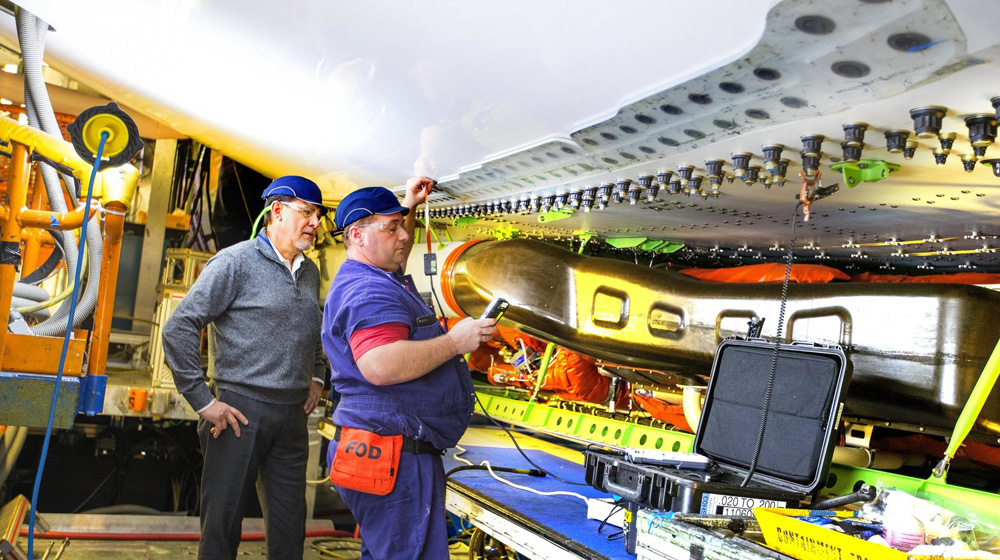
Ernesto Gonzalez-Beltran, VP of Quality at Boeing Commercial Airplanes, left, looks on as mechanic Ken Zabel uses a Bluetooth-enabled device to measure gaps between sections at the wing-to-body join on a Boeing 787. (Mike Siegel / The Seattle Times)
Article By Dominic Gates
Boeing Everett mechanic Ken Zabel is using a handy new tool that halves the work involved in one intricate job where the wing and fuselage of a 787 Dreamliner are joined together. Boeing says the device is so accurate it also cuts out the need for a quality inspection.
That elimination of a check for defects is part of a sweeping transformation of Boeing’s quality system that’s now being implemented throughout its production lines.
The ambitious revamp includes changing the design of parts to make them easier to build right, adjusting the sequence of work to make assembly simpler, and adding tools and automation to ease the jobs of the mechanics.
But one element of what Boeing is calling its “Quality Transformation” has unnerved the Machinists union and current quality inspectors: The company told the union last month it will eliminate thousands of quality checks as no longer necessary.
Boeing said it will cut about 450 quality-inspector positions this year and potentially a similar number in 2020.
In the Puget Sound region, there are currently just over 3,000 Boeing Quality Inspectors, who typically work as a second set of eyes. For each of the tens of thousands of jobs that go into assembling an airplane, they formally sign off that it has been completed and done right. By the end of next year, Boeing’s plan would bring that down to not many more than 2,000 people.
Nevertheless, the company insists the overall changes will improve quality and reduce the need for rework.
“This is a shift in thinking,” said Ernesto Gonzalez-Beltran, vice president of quality, before a production line tour at the Everett jet-assembly plant. “It will take some time, but we believe it will make our quality better … The initial outcomes are very reassuring that we are on the right path.”
Auto manufacturing as the model
Quality inspectors check wiring connections. They check the dimensions of holes that must be precisely drilled in metal or composite parts. They check the torque applied to a nut. They check that components are made from materials that meet Boeing specifications. Before any part of an airplane is closed up, say by putting down floor panels or adding sidewall insulation blankets, they check that the area is free of debris.
And in accordance with Federal Aviation Administration (FAA) requirements, they record every check as part of an immense regulatory system designed to document the safety of every plane that Boeing rolls out.
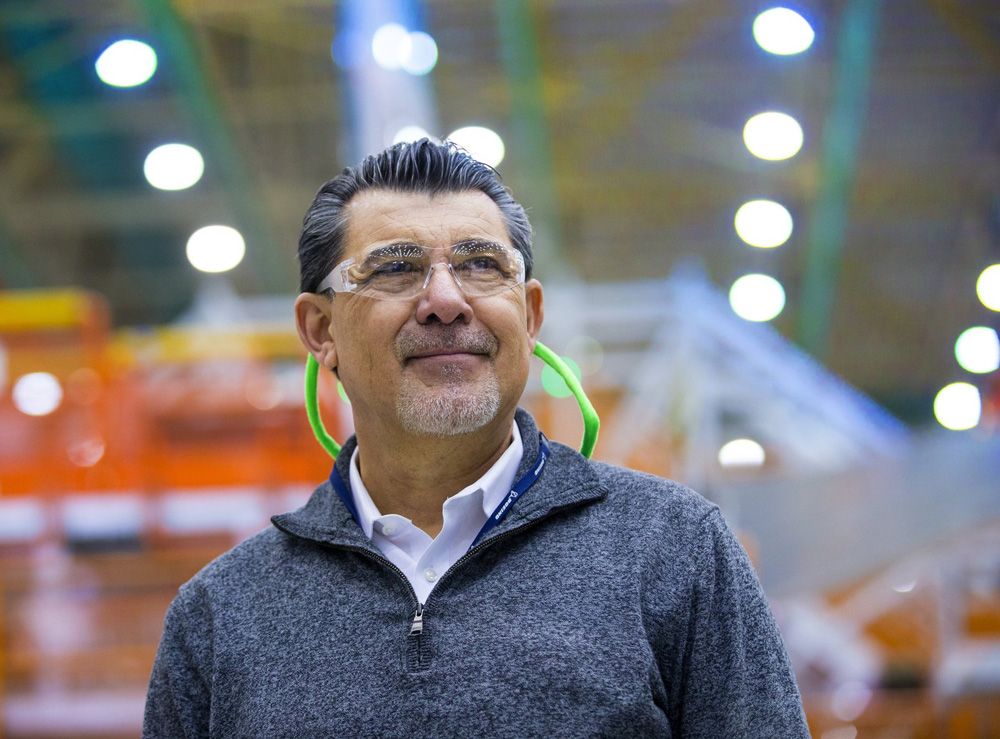
Ernesto Gonzalez-Beltran, VP of Quality at Boeing Commercial Airplanes stands by the 787 assembly line in Everett. (Mike Siegel / The Seattle Times)
Boeing envisions a new streamlined production system that builds every component and performs every task without defects from the get-go — “built right first time” — so there’s no need for every last detail to be inspected afterward.
The model is the high-volume auto-manufacturing industry, and at Boeing the transformation is spearheaded by former auto executive Gonzalez-Beltran. He joined Boeing Commercial Airplanes just over 18 months ago and has quickly accelerated implementation of the new plan.
Born in Mexico, Gonzalez-Beltran worked there as well as in the U.S. and Brazil for Ford Motor Co., in all spending more than 32 years in the auto industry.
Working for Toyota in California, he saw how streamlining, simplifying and standardizing final assembly work revolutionized efficiency and quality there, and later at other auto manufacturers.
“I see the future,” he said. “Because I have seen it in the auto industry.”
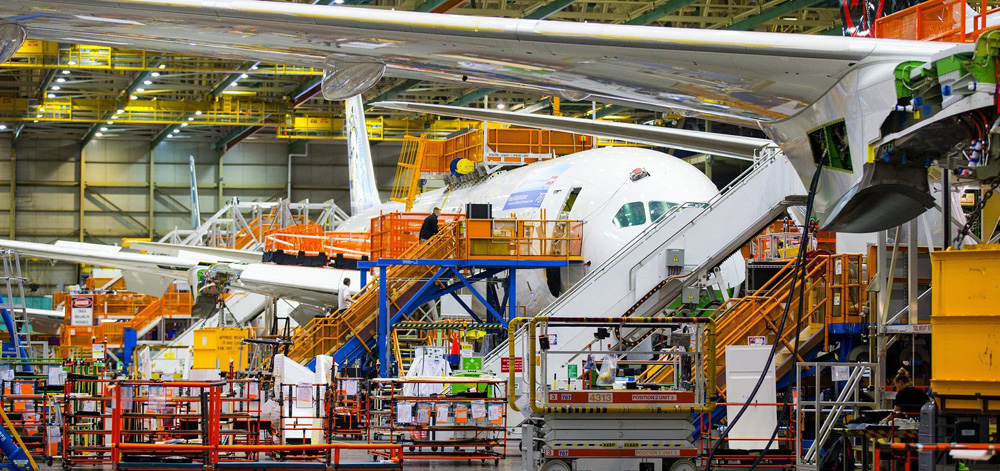
Boeing 787s in different stages of completion on the final assembly line in Everett. (Mike Siegel / The Seattle Times)
The Machinists union balks
For Jon Holden, District 751 president at the International Association of Machinists (IAM), the central concern is job losses.
“They’ve notified us they are trying to eliminate thousands of inspection processes,” said Holden in an interview. “That will eliminate jobs.”
The union and Boeing are now in formal negotiations on the impact of the changes, and the company won’t disclose specifics. But Gonzalez-Beltran insisted the worry about job losses is misplaced because Boeing is increasing production rates and hiring people.
“We’re actually bringing more people in,” he said. “We are not right now in any way, shape or form foreseeing any reduction. I don’t foresee any loss of jobs because of this at Boeing.” He said displaced inspectors will be moved to other work.
Still, Holden said that if Boeing cuts up to 900 positions over two years, that’s a lot of people for whom work will have to be found elsewhere.
“We do have great concern that this will lead to layoffs,” he said.
The IAM held meetings of its members last month, declaring, “It’s not OK to cut QA” (Quality Assurance).
Aero Mechanic, the District 751 monthly newspaper, accused Boeing of “essentially masking defects,” by pressuring inspectors to not record defects when found but instead to simply have them fixed, then afterward produce data to the FAA showing a big decrease in defects as a justification for cutting out inspections.
And employees attending the meeting expressed concern that removing inspections risked making planes less safe, according to the union paper, which quoted one inspector calling it “a dangerous idea.”
New smart tools
On the production line tour, Boeing eagerly showed off new technology capabilities that play into its quality transformation.
Working underneath a 787 wing, mechanic Zabel slipped a thin electronic ribbon into the small gaps between the body of the aircraft and the thick metal plates that lock the fuselage to the wing. The ribbon measures the gap at the location of each of 120 bolts; based on Zabel’s measurements, Boeing fabricates precise shims to fill each one.
This used to be a more painstaking, time-consuming process, where Zabel inserted a “feeler gauge” and by trial and error determined how many thin layers of metal it took to plug each gap, then wrote down in a ledger the gap measurement at each bolt.
Now Zabel doesn’t need to write anything. The new tool connects with Boeing’s computer system via Bluetooth, automatically recording each measurement and sending the data to the shop that fabricates the shims.
It’s not only quicker, it’s more accurate, said Zabel’s boss, Robert Handshy, the 787 wing-to-body join manufacturing manager.
“We hardly ever reorder a shim any more,” Handshy said.
Previously, to ensure each locking plate was secure at every point, a quality inspector would have checked Zabel’s work. When the tool was introduced those inspections continued until Boeing data showed the work was now producing few defects.
“When we first went to this system, (the quality inspectors) checked every airplane,” said Zabel. “But it’s now a proven process, so they only check periodically.”
The introduction of sampling instead of comprehensive inspections of every job is a key part of Gonzalez-Beltran’s changes.
“Instead of checking 100 percent, they will check once every 100 parts or every 1,000 parts,” he said.
Natalia Roberts, an engineer from Boeing’s Research and Technology (BR&T) division, showed another innovation aimed at reducing the risk of human error: a digital wrench that signals when the correct torque is applied to a nut and automatically sends the data via Bluetooth into the computer system.
And while mechanics today must mark each nut they tighten to ensure none is missed, that will no longer be necessary, Roberts explained, because BR&T has programmed the wrench so that “it tracks that you have done all the operations in a predetermined sequence.”
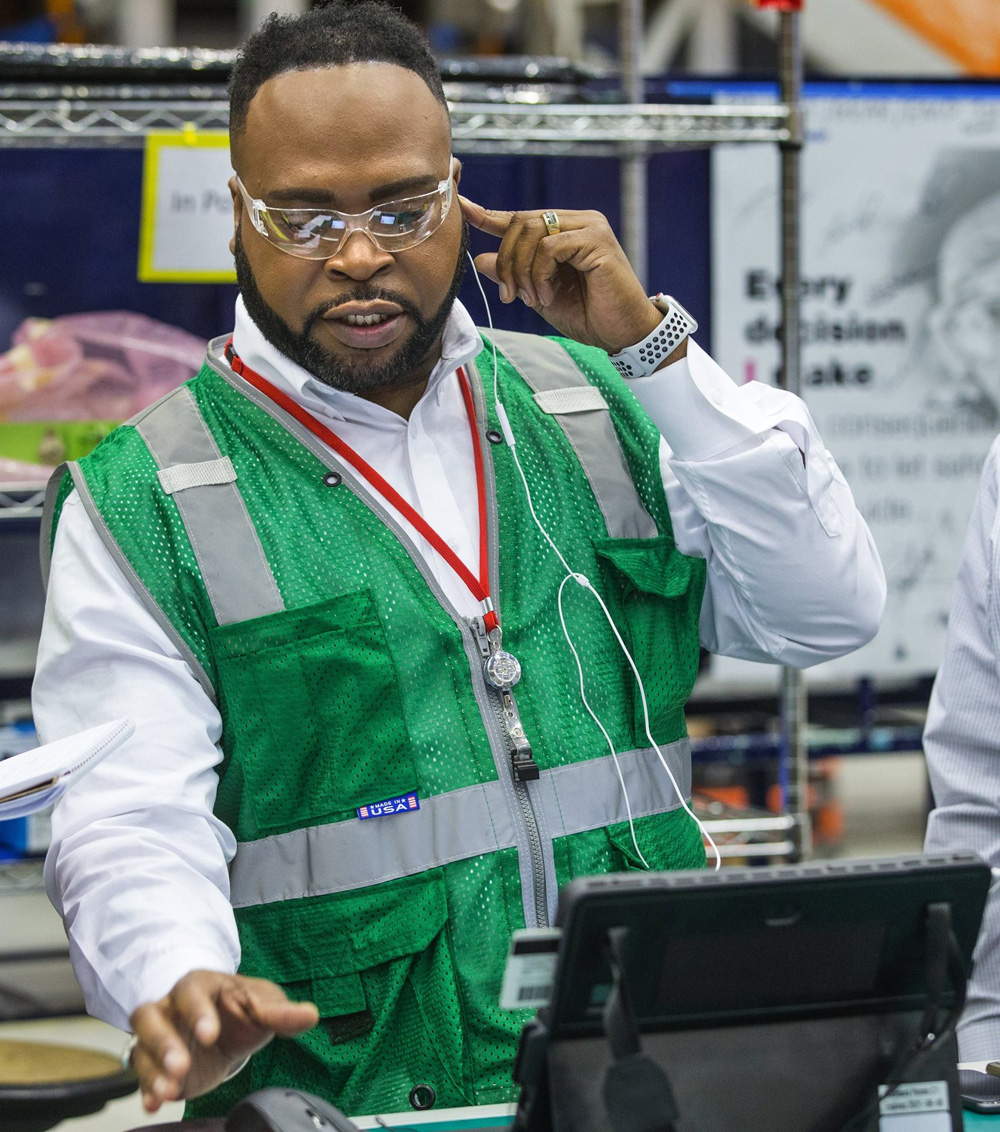
Monzelle McWilliams, a manufacturing operations analyst, uses a computer tablet for mobile access of work orders, drawings and specifications. (Mike Siegel / The Seattle Times)
This new smart wrench will be used initially on the 737 and 777 programs to tighten the nuts in the hydraulic lines. Boeing plans to gradually deploy it across all jet models in Everett, Renton and in South Carolina.
Along with such gee-whiz technology, Boeing is simplifying work procedures to reduce defects.
John Hamilton, vice president of engineering at Boeing Commercial Airplanes, cited the way thick wire bundles are connected inside an aircraft. Electricians must pin connectors from one set of wires to the next along the length of the plane, with the risk that the wrong wires may end up connected.
“We’ve changed the design of some of the connectors to Murphy-proof it, so you can’t hook it up incorrectly,” he said.
FAA monitoring Boeing
Gonzalez-Beltran said Boeing data show that inspections are “at best 87 percent effective” in spotting defects and that the approach it is now implementing can produce better results.
“Right now, everybody is dependent on a second person to come around. We’re trying to walk away from that and give them the respect and the tools to actually confirm that they did a good job,” Gonzalez-Beltran said. “The responsibility goes to the mechanic.”
An internal Boeing document providing “talking points” for managers, obtained by The Seattle Times, points another motivation for the company: faster completion of tasks: “By allowing the mechanic to verify their own work, wait time is eliminated.”
Boeing cannot move forward with such a radical shift in its manufacturing processes without the approval of the FAA.
One item in the “talking points” document says Boeing is working with the FAA “to help them understand that these changes will not jeopardize our quality, but will in fact lead to higher levels of quality.”
The FAA “endorse and understand this,” Gonzalez-Beltran said.
FAA spokesman Gregory Martin said the regulatory requirements for inspection of airplane-manufacturing work have not changed, and that Boeing is changing only the methods it uses to conducts inspections and verify compliance to standards.
“We will continue to monitor their progress,” he said.

The nose section of a new Boeing 787 Dreamliner jet under assembly in Everett. (Mike Siegel / The Seattle Times)
Improved quality or false data?
To convince the FAA, Boeing has compiled data on how it is reducing defects. The Seattle Times obtained an internal Boeing chart compiled in December that shows the number of defects per airplane for each jet program and compares the figures in 2017 to 2018.
Only the 767 program, which includes the Air Force tanker, showed slightly more defects per plane in 2018. Every other program showed fewer defects, with an overall reduction of 20 percent.
“I see my defects coming down. I see my rework coming down,” said Gonzalez-Beltran. In 2018, he said, Boeing went after “the lower hanging fruit” but this year, as the changes accelerate, “I’m expecting a very, very radical change in overall quality.”
The union is suspicious that this data showing fewer defects has been massaged to make a case to the FAA that inspections can be dropped.
At the December union meeting, several inspectors spoke of being pressed by managers not to write up nonconforming parts or to write “pickups” for rejected parts. Instead they were urged to have defects fixed, without a record.
A violation of manufacturing procedures documented by the FAA last month offers evidence of that practice.
FAA investigators substantiated a complaint by a whistleblower working at Boeing’s Electrical Systems center inside the Everett plant. They found that quality inspectors had issued final acceptances on some wire bundles, although afterward Boeing employees reworked the wiring to fix defects, without writing a record of the work.
The FAA also noted that an earlier complaint alleging similar violations was also substantiated.
Gonzalez-Beltran said these were isolated cases of employees not following company procedures.
“Unfortunately, there are situations where people, through lack of understanding or awareness, bypass one or two steps,” he said. “In those cases, we have to find ways to ensure our own people follow our guidelines.”
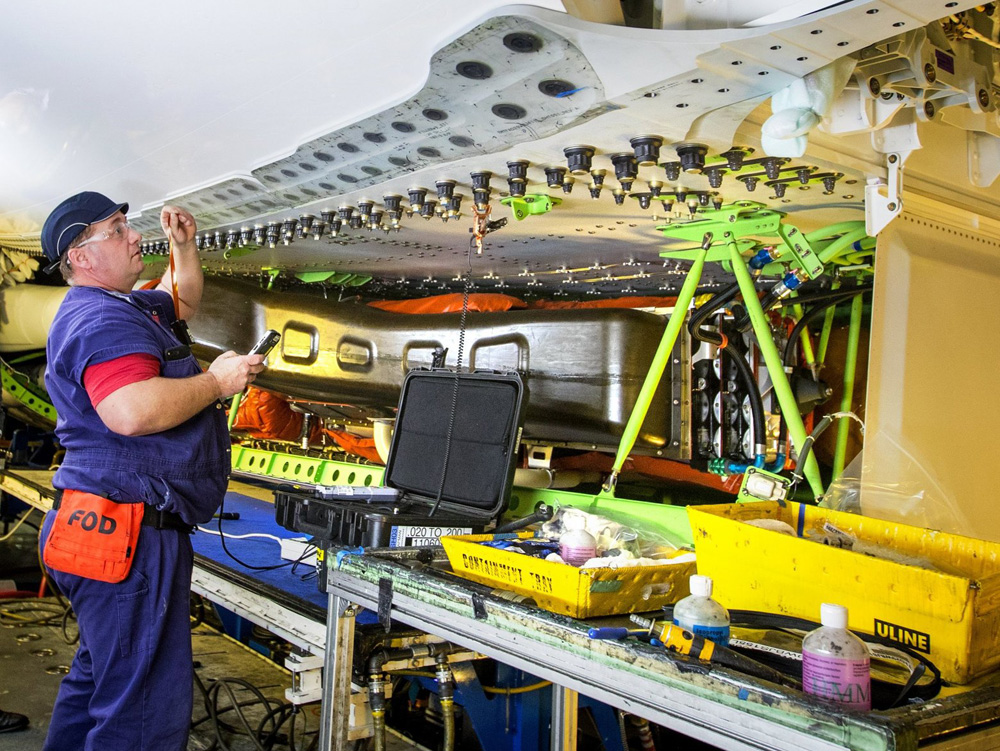
Mechanic Ken Zabel uses a Bluetooth-enabled device to measure gaps between sections at the wing-to-body join on a Boeing 787. The system automatically records and stores the data and expedites the process of ordering shims to fill the gaps. (Mike Siegel / The Seattle Times)
More responsibility on the mechanic
Two current Boeing quality inspectors who approached The Times independently of the union, and spoke without company authorization on condition of anonymity to protect their jobs, said they’re deeply worried about the changes.
The first said dropping quality inspections “is absolutely a safety issue.”
He said the supposed drop in defects used to justify reducing inspections is the result of factory managers creating “a bullying environment,” pressing inspectors to sign off on work. It’s driven by the need to keep production humming — despite what he sees as multiple instances of “poor workmanship and hidden defects.”
“They’ve sold the FAA a rotten bill of goods,” the inspector said.
The second inspector said he too doubts Boeing’s data because many older, more experienced mechanics left Boeing in the past couple of years and have been replaced with new young hires, many with almost no experience.
“I’ve seen the attitude within the ranks of the younger employees. It’s more complacent,” he said. “I’d expect more defects, not fewer.”
And he said engineering staff can override an inspector’s defect report “if it doesn’t affect fit, form or function,” so some inspectors decide it’s not worth the time and effort to write everything up.
“The defect has not gone away,” the second inspector said. “It’s just stopped being documented.”
Both inspectors cited standard safety checks that have already been dropped in some areas.
Checks that holes have been drilled precisely and accurately are no longer done. Mechanics can close up areas of the airplane without an inspector taking a final look.
And inspectors no longer check the bolts on a holding fixture used to lift large fuselage panels by crane — a safety measure added more than a decade ago when a bolt gave way and the crane almost dropped a panel onto those below.
The second inspector said the daily grind of a mechanic’s work can lead to errors.
“You get into a routine. You miss things,” he said. “That’s what the inspector is for, to look past the overconfidence or fatigue and see the defects.”
Gonzalez-Beltran, however, insists he’s getting positive buy-in from mechanics who take pride in performing their work without an inspector’s oversight.
“People feel good about it, feeling they have ownership,” he said. “They are stamping it saying, ‘This is good. I built it. I did it right. Move on. I don’t need somebody else to come and check it.’”
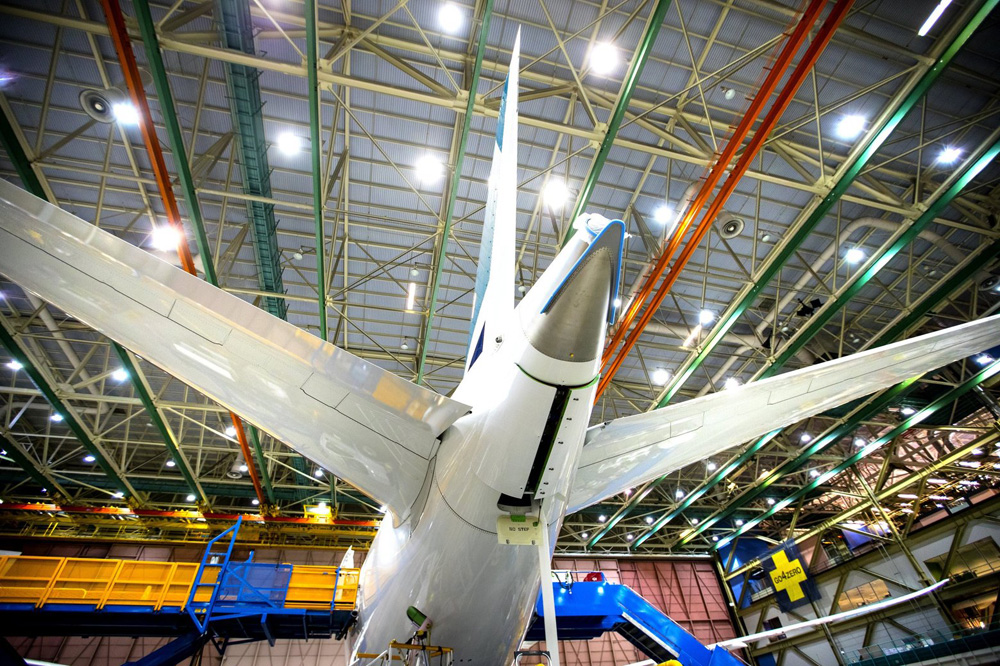
A 787 tail section along the final assembly line in Everett. (Mike Siegel / The Seattle Times)
My Thoughts
Randy R. Murray fodprevention.com
In a perfect world technical automation sounds exciting to those that wish to save a buck, But as we all know and as the article states technical automation leads to lost jobs and wadges that eventually hurts the economy.
The more we remove the human from the equation the more we hurt our selves. A human being looking for errors or flaws in work areas is more that just a pair of eyes, we are the heart behind the job. We care about the quality of the end product because we know these planes need to be in the air and need to be safe.
After all are we not we making planes for us to travel in?
The battle for FOD control is hard enough as it is, These automated systems maybe accurate for finding flaws or defects in systems and materials.. But do they search for foreign objects that should not be there in the first place?
Or do they simply scan the foreign object and send back data stating.. this object has no flaws?
Unless these types of variables are programmed into the system before automation begins we maybe never know the true count of removing the human eye!
Giving how many object could end up in a wrong area, an automated system would have to have millions of added variables to calculate for all given items.. When a human can simple say “Oh there’s my pen.. I sure am glad i spotted that”
Boeing overhauls quality controls: Good or Bad for FOD? Click To Tweet

